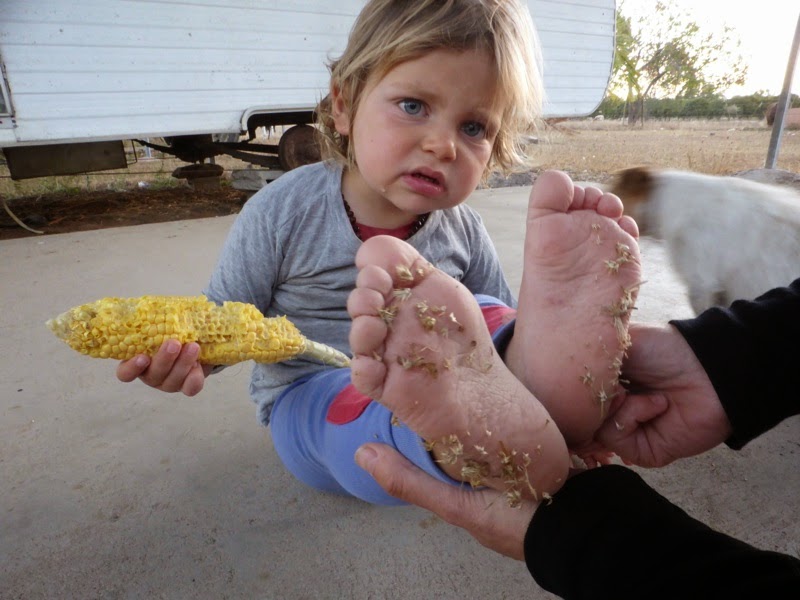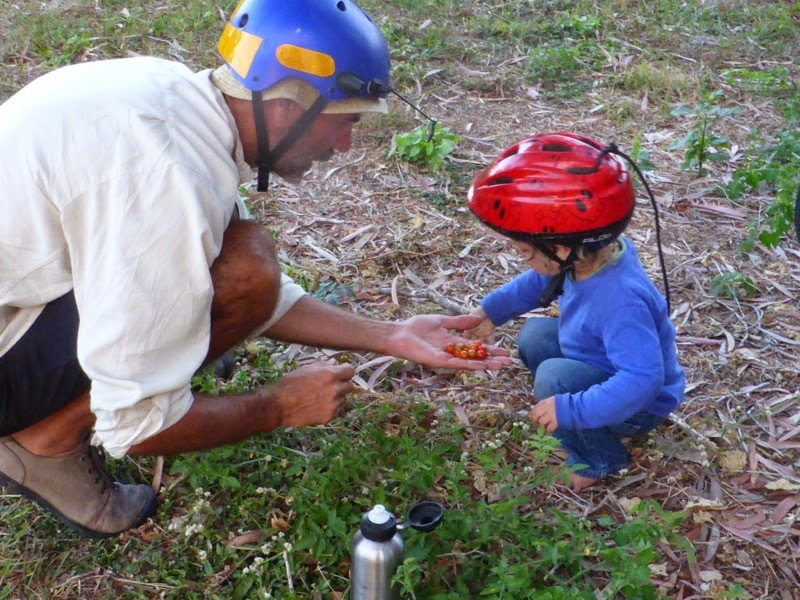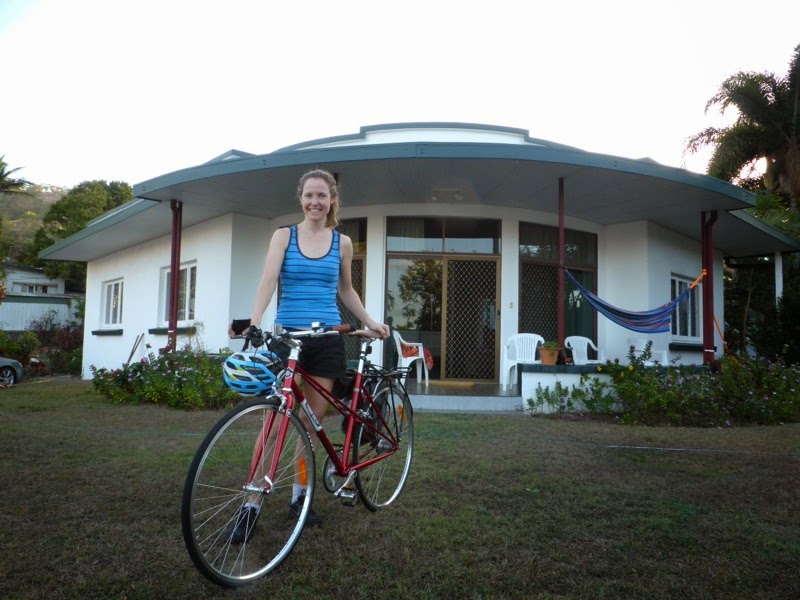On leaving Airlie Beach we discovered this woody vine and stopped to investigate.
Despite all our best efforts we haven't been able to work out what plant produces such a fruit and whether it is at all edible. Perhaps you can help dear reader? [UPDATE: Thanks Amanda Ramsay for identifying this fruit as the creeping or climbing fig (Ficus pumila var. awkeotsang). Apparently in Taiwan the fruit is dried for eating and the seeds help form a jelly.]
We left our mystery fruit, collected some roadside citrus and Black Sapote (Diospyros nigra),
raced a cane train engine back to the Bruce Highway (thanks for the peg Tim Burder!),
and discovered our first cocky apple (Planchonia careya), a traditional bush food of the north.
It was a long day in the saddle riding 80 kms to windy-as-hell Bowen, where we took an obligatory peg under the big mango (note the edible, fruit-loving green ant, which we still have to try).
Bowen is a kind of birthplace for the mango industry in Australia, dating back to the 1880s when the Kensington variety was first grown for commerical purposes. Now mangoes have naturalised and are considered weeds by landcare groups where they grow without monetary intention. Sadly we're too late (or is it too early?) for mangoes freely foraged or commercially grown.
We also discovered bananas that have naturalised in this region,
and another weed of great significance for a country arriving at peak affluence, coconuts!
We have so enjoyed this nut, which is so freely available everywhere along the coast. We have developed a fast technique to remove the husk (note the hatchet) and to drill through the eyes (note the three-pronged fishing spear head) to extract the nutritious milk. Every tool we carry has to have multiple uses.
Bowen was a haven for new species we hadn't previously documented. We came across another strange fruit, which despite all our reference books and online searching we also haven't been able to identify.
We discovered bush passionfruit (Passiflora foetida),
Burdekin plums (Pleigynium timorense),
and the (apparently) good eating brush turkey (Alectura lathami),
all at Horseshoe Bay. This little place was something quite special.
On the beach we noted the forageable and medicinal but nonetheless potentially poisonous goats foot (Ipomoea pes-caprae). Traditionally, the fleshy part of the taproot was removed, washed and then steamed over coals wrapped in pandanus or some like leaves, making the root edible.
Bowen is also a town of citrus at this time of year and we knocked on several doors to ask if we could harvest a little. While there is still little value given to fruit grown on trees in front and backyards, it is easy pickings to travel Australia and everyday find something good to eat.
Bowen is also a town of capsicum and tomato monocultures,
and like all conventionally grown fruit, petrochemical pesticides are absolutely necessary, and significant waste goes with the territory. This is one season's weed matting and irrigation pipe ready for the tip.
We left Bowen spotting Mexican prickly poppies (Argemone mexicana), a traditional medicine plant of Sonora in Mexico, used to treat severe headaches and constipation. The oil the plant produces (katkar oil) can be toxic and has been known to cause epidemic dropsy in humans when other edible oils (especially mustard seed oil) have been adulterated by it. Notably severe headaches and loose bowels are just some of the symptoms produced by poisoning.
While the dry tropics at this time of year have been conducive to living outdoors, the temperature increases as we head north make for thirsty cycling.
We rode a short leg to Gumlu where we paid $10 to camp the night and take a warm shower,
at a caravan park that's seen better days,
and is now in transition to an energy descent scenario.
Woody found a store of corn kept for the animals, helped himself and also picked up some unwanted guests.
It was at Gumlu Caravan Park that we first tasted Ber fruit (Ziziphus mauritiana), also known as Chinee Apple, Jujube, Indian plum and Masau. Look how appley they look.
It is a rather dry fruit, not overly sweet but much richer in Vitamin C than all types of citrus. As Woody will tell you the orange fruit indicates they're ready to eat.
We harvested a bunch for the road,
set out to seek more species but for a while only found 'nature' just south of Ayr,
crossed a rather big bridge,
and set up home in a park south of the town.
It was in Ayr we first came across candle nut (Aleurites moluccana), which gets its common name from its traditional use as a light source. This very oily nut can be burnt as a candle.
We were also introduced to the beach cherry (Eugenia reinwardtiana), otherwise known as the Ceder Bay cherry.
This was a delicious, moist, sweet find and we relished the few fruit we consumed.
On the way out of Ayr we discovered our third mystery fruit for this 300 km leg.
We asked the owners of the property we found it on, but they had no idea. Even though our main research focuses on naturalised, uncultivated food sources, anything edible, medicinal or useful is of interest, especially those species that yield much food,
and can lead us away from sickness.
We rode to a little sugar cane town called Giru, and asked a local man whether we could harvest his Kumquats. He happily obliged.
Beside this abundant tree was a Jackfruit (Artocarpus heterophyllus). We tapped on the larger fruits to see whether they were hollow and ready to eat, but we were too early in the season for them.
We stopped at the local pub for an afternoon ale and got the lowdown on free camping in Giru. As we pulled up and we adults began to set up, Woody noticed little red fruits at our feet.
Naturalised tomatoes. Yum!
We threw them through a pasta with locally gardened garlic and olive oil before rumbles in the tent.
With the new day we had a rather testing ride into Townsville with gusty side winds and disappearing shoulders,
arriving fairly exhuasted to stay with Becc, a local bicycle advocate and warm showers host.
Becc took us down to The Strand for a cultural parade that had little to do with 'Team Australia' and all to do with celebrating diversity,
and cooked us a beautiful dinner which we enjoyed with other lovely local cycle tourists. We'll stay a little while in Townsville and rest up to ready ourselves for our next leg of discovery.














































On referral from a friend (Jessie from http://rabidlittlehippy.wordpress.com) in Ballan (an ardent fan who cant wait for a workshop on foraging in your/her local area) i discovered your blog today. Ive just spent a lovely Sat night reading about your trip from go to whoa except its not because its still ongoing and im loving it. Can i say that you are an amazing family and Woody and Zeph are in for an adventurous life. Looking forward to reading your other blog as well. Lynda (Hoppers Crossing).
ReplyDeleteHello hello Lynda, lovely to hear from you. We are just back from an amazing week on Palm Island and catching up with correspondence. Thank you so much for your well wishes and encouragement. We hope you enjoy our latest post centred on Palm that we've just published.
ReplyDeleteHello hello Anon! Thank you so very much. It looks as though you are indeed correct. So good to know about the elephant apple and now to be able to find out more. Cheers, AaF
ReplyDeletenice site ..:) keep it up God Bless
ReplyDeleteYo.
ReplyDeleteTwo remaining mystery plants:
* Dillenia indica (not Australian native and common name in Australia so called Elephant Apple and other common names)
* Clerodendron spp. – one of the numerous species in this genus—more visible plant material is required to positively identify this to species level, albeit almost certainly an Australian native and locally indigenous species of this genus, which nearly all species found in this continent today are natively occurring.
—in the SE of this continent i’m a professional field botanist–ecologist and on middle age professional development to field botany–ecology in NE. of this continent —a 'sahul' bushman.
—a clue: "Dark Emu" – please look it up … .
Go well,
S. J.